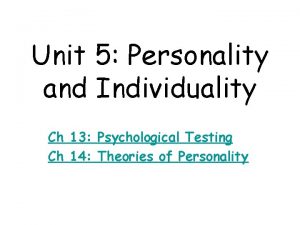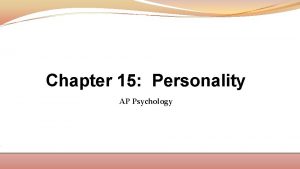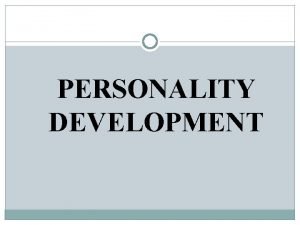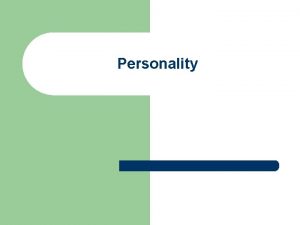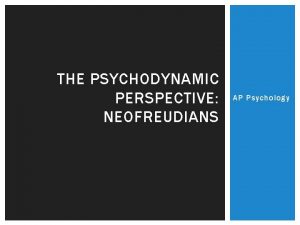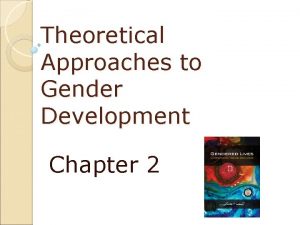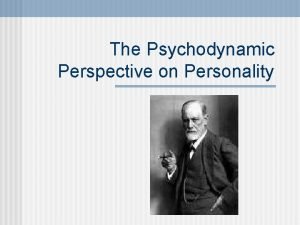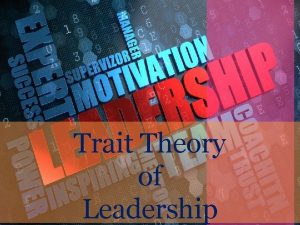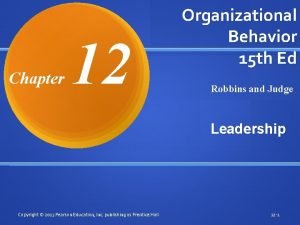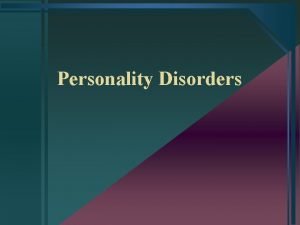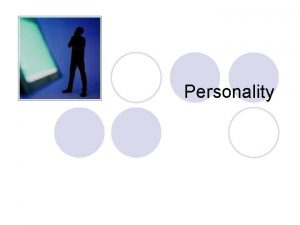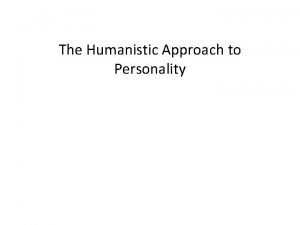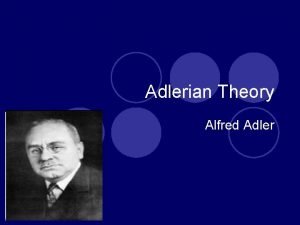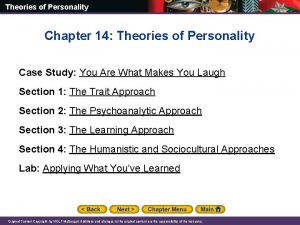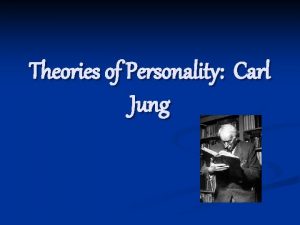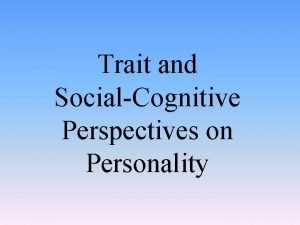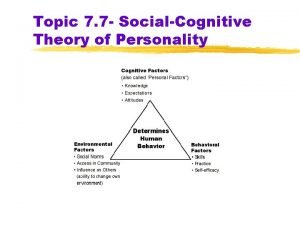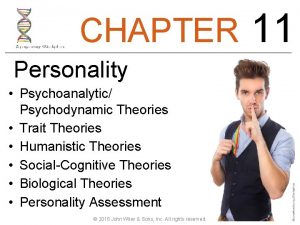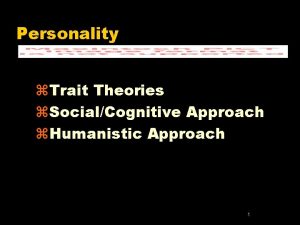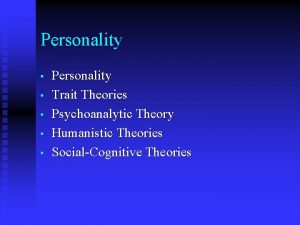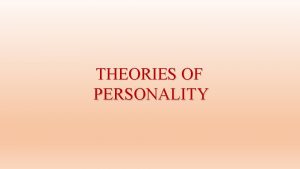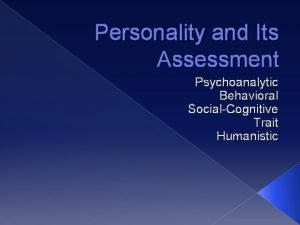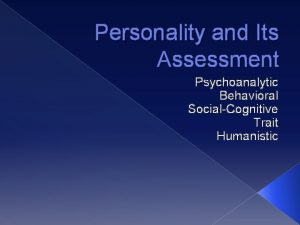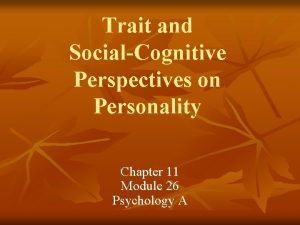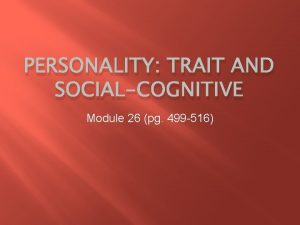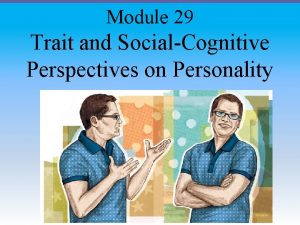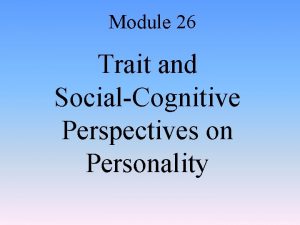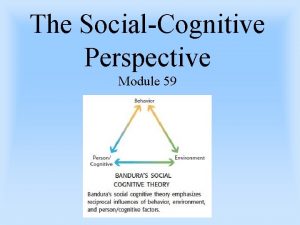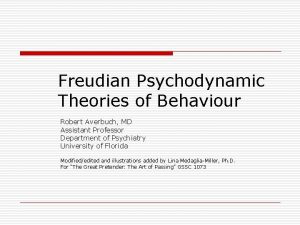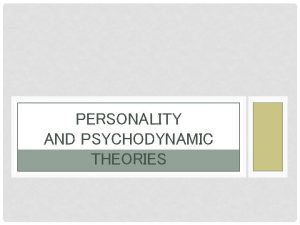Theories of Personality Freudian Trait SocialCognitive Psychodynamic Theories


































- Slides: 34

Theories of Personality Freudian, Trait & Social-Cognitive

Psychodynamic Theories of Personality

Psychodynamic Theories of Personality Like most of the work derived from Sigmund Freud’s Psychodynamic Theory, as well as those who followed him (Carl Jung, Alfred Adler, others), this information is primarily important for historical reasons and the development of the field. There is very little empirical evidence for these studies and theories. If you recall, Freud’s theories were primarily centered on the “psyche”, broken up into three parts: the id, the ego, and the superego. As a refresher, the id is the irrational, impulsive, and emotional part of the brain that pushes a person to seek immediate gratification. The ego is the rational part of the brain that considers prospective outcomes and makes long term decisions. The superego is the moral part of the brain that seeks socially acceptable outcomes that follow one’s values.


Defense Mechanisms Freud also placed great importance in what he called the “unconscious” mind. He believed that much of what makes up our personality comes from our unconscious, and our observable personality and behavior comes from our defense mechanisms, strategies we use to protect ourselves from our negative unconscious thoughts. There are several defense mechanisms proposed by Freud, including: Denial is refusing to acknowledge something. Repression is pushing something out of your mind so you do not think about it. You don’t actively deny it; rather, you just decide not to think about it and eventually forget it. Reaction formation is convincing yourself of the opposite of what is actually true.

Defense Mechanisms, continued Projection is attributing an unwanted trait or thought to someone else. Rationalization is coming up with a logical, rational (but false) explanation for a shameful thought or action. Intellectualization is converting a threatening trait or thought into a cold, intellectual fact. Displacement is redirecting an unwanted impulse toward something more acceptable. Regression is reverting to an earlier stage of life development when you are faced with conflict. Sublimation is converting shameful impulses into something noble; redirecting the energy to something more acceptable.

Psychic Energy and Release Freud believed that people repressed negative emotions and revelations about themselves. In order to do this, however, we had to use what he termed “psychic energy”, and we could only use so much. Thus, the more we tried to contain, the more stress and unconscious struggles we would experience. He believed in the use of free association to free up psychic energy: this is the practice of freely saying everything that comes to mind, which allegedly allows some of the unconscious turmoil to be released. He believed that dreams could also provide insight into these struggles, and that dream analysis could be used to understand the unconscious. Finally, the unconscious can leak out through slips (sometimes called Freudian slips) such as calling your boyfriend by your former boyfriend’s name.

Psychosexual Development of Personality Freud argued that early childhood experiences were incredibly important in the development of personalities, and are reflected in adulthood. He believed that there are 5 stages of early childhood development, each based around a particular physical (sexual) trait. The failure to progress through these stages results in fixation, which is the lingering focus on these stages for pleasure reasons. Freud believed that passing through these stages, or the failure to do so, heavily shaped adult psychology and personality.

Stage One: The Oral Stage According to Freud, from birth to about 18 months of age, the biggest psychological struggle babies face is their dependence on others. The physical focus of this stage is the mouth, tongue, and lips. Failure to successfully pass through this stage can lead to the adult personality characteristic of being overly dependent or its opposite, overly independent. Oral fixations include using the mouth to self-soothe under stress, such as smoking, biting fingernails, employing sarcasm, etc.

Stage Two: The Anal Stage According to Freud, from age 18 months to 3 -1/2 years, the primary struggle children face is obedience and self-control. Children typically go through potty training during this stage. The physical focus of this stage is the anus. Failure to successfully pass through this stage can lead to the adult personality characteristic of being extremely rule-abiding and obsessed with order (anal retentive) or its opposite, being rebellious, chaotic, and anti-authority (anal expulsive).

Stage Three: The Phallic Stage According to Freud, from age 3 -1/2 to 6 years, the primary struggle children face is figuring out their gender identity and sexuality. The physical focus of this stage is the sexual organs. Failure to successfully pass through this stage leads to the adult personality characteristic of being over-sexualized (e. g. , flirty) or its opposite, being undersexualized (e. g. , overly modest).

Stage Four: Latency, Stage Five: The Genital Stage From age 7 years to puberty, children do not face any special psychological struggles and are not fixated on any body part. All earlier issues remain hidden in the unconscious. According to Freud, from puberty onward, the primary struggle is the creation and enhancement of life. Freud believed that people rarely completely resolve this struggle, but if they were to, the result would be a healthy, mature adult personality. There is no particular body part associated with this stage, though the physical focus more generally is one’s sexuality, especially in relation to others (i. e. , intimate relationships).

Evidence for and against Freudian Personality The idea that people are unaware of all of their motives has held up well to scientific scrutiny. Researchers have shown people can be unaware of some of their motives, and sometimes they can even be unaware of some of their feelings and behaviors. However, other details about the unconscious proposed by Freud have held up less well to scientific scrutiny, and ultimately there has not been much scientific support for Freud’s ideas about psychosexual development. Furthermore, research to date has not turned up much evidence that early childhood experiences influence personality.


Trait Theory of Personality

Trait Theory of Personality Traits are psychological dimensions such as extroversion, tidiness, emotional stability, and curiosity. The trait approach, the approach most often adopted by personality researchers, rests on the assumption that people differ from each other on continuous traits; there are not distinct groups, for example “extraverts” and “introverts, ” but instead there is a continuum.

Classification of Traits The main goal of the trait approach to personality is to catalog all of the dimensions (traits) on which people vary and create a classification of traits that reflects which traits tend to go together. For example, Talkativeness, sociability and assertiveness are all distinct traits, but they also have a lot in common. Ideally, the trait approach would lead to a classification system that tells us what “groups” of traits exist and which traits are in which groups. These groups composed of personality traits are often called personality factors.

Benefits of Trait Psychology Traits have proven extremely useful for describing personality and predicting people’s characteristic patterns of thinking, feeling, and behaving. The trait approach actually cuts across many different theoretical orientations (theories), because traits are a way to conceptualize and measure how people differ from one another. Whether a personality psychologist believes in a psychoanalytic theory of personality or a biological theory, that psychologist will need named traits to talk about personality and individual differences.

Limits of Trait Personality Rather than proposing a theory about what causes personality, the trait approach focuses more on how to describe personality—what are the traits on which people differ? Thus, the trait approach has been criticized for being purely descriptive. It is true that traits do not really provide a deep explanation for why people differ. If Julia’s desk is neater than Joe’s, and someone explains it is because Julia is tidier than Joe, not much has been explained about either one’s behavior or personality.

The lexical hypothesis is the idea that the concepts important to us will be represented with words in our language. Thus, the personality traits that exist should all have words associated with them. Researchers decided based on this hypothesis they could identify all the traits by looking through the dictionary.

Historical Personality Trait Theory Gordon Allport viewed personality as consisting of cardinal and central traits. His theory was less concerned with explaining why and more concerned with describing how people differ from each other. Raymond Cattell used factor analysis to identify 16 personality traits. The degree to which a person possesses each trait forms his or her unique personality profile. Hans Eysenck used factor analysis to determine basic factors, which included introversion versus extroversion and emotionality versus stability.


The Big Five By asking hundreds of people questions about their personality based on certain adjectives, personality psychologists were able to group them into five main factors of personality (traits). These traits are: Extroversion vs Introversion: Extraverts are outgoing, assertive, enthusiastic. Introverts are quiet, reserved, and rarely impulsive. Agreeableness: People who are agreeable tend to be cooperative and compassionate. High levels may be non-confrontational, low levels can be stubborn. Conscientiousness: People who follow the rules and are self-disciplined. High levels are organized and hardworking, low levels are messy and spontaneous. Neuroticism: the tendency to experience a variety of distressing emotions. It includes traits like anxiety and self-doubt, impulsivity, anger, and hostility. Openness to experience is the broadest factor. It includes traits like creativity, appreciation of art, curiosity, and unconventionality. High levels try new things, low levels stick to routine.

Personality Types Many people refer to a personality trait as if it represents a type of person, like extroverts and introverts. However, this is misleading, as true trait approach has people with different levels of many personality traits. While people may differ from one each other, and a label like “loudmouth” may hint at extroversion or a lack of agreeableness, labels are not accurate as people differ by degrees, not all or nothing.

Social-Cognitive Theories of Personality

Behaviorism is theory that people’s behavior is the result of the rewards and punishments they have experienced in the past. Applied to personality, behaviorism is the view that people are different from one another because they have experienced different patterns of rewards and punishments, which have reinforced different behaviors in different people; therefore, they have developed different personalities. For example, a person whose parents laughed at her jokes all the time might end up making more jokes later in her life than someone whose parents did not react when she made jokes.

Social Learning Theory Social learning theory is based on behaviorism but adds one crucial element: the view that what shapes behavior is not only the actual reinforcements (rewards and punishments) that people experience, but how the people interpret these reinforcements. Social learning theory also says people can learn from observing other people being rewarded or punished.

Albert Bandura emphasized that people’s perceptions of reality might be more important than reality itself. Bandura placed special emphasis on people’s expectations about their own efficacy. Self-efficacy is a person’s belief about whether or not he or she is capable of bringing about desired results. It varies from person to person, and also situation to situation. A person can have high self-efficacy in academics or work, but low self-efficacy in dating or sports.

In his social learning theory, Bandura also emphasized how people can learn from others. People, especially children, are more likely to perform a behavior if they have observed others do it, especially if they have seen others rewarded for this behavior. Bandura’s famous Bobo doll studies showed that kids are more likely to treat an ambiguous toy (the Bobo doll) in the same way they observed an adult treat the toy. For example, if a child watched an adult repeatedly hit the Bobo doll, the child was more likely to hit the doll.


Bandura emphasized people often have some say about which environments they find themselves in and what behaviors are rewarded or punished in these environments. Thus, personality is not only shaped by a person’s environment, but personality also partly influences which environments the person chooses in the first place. A person’s personality can also alter the environment. For example, a gregarious, assertive person may become the captain of her basketball team and change the team environment just by being on the team.

Julian Rotter’s Expectancy-Value Theory Expectancy-value theory predicts people will weigh potential rewards according to their subjective probability. People are more likely to perform a behavior if they believe there is a high probability the behavior will lead to a reward than if they believe the probability of a reward is low. Julian Rotter further proposed people might differ from one another in their generalized expectancies; some people might generally feel they are capable of behaving in a way that elicits rewards.

Locus of Control People who have an internal locus of control believe they are able to control the rewards and punishments they experience with high probability. People with an external locus of control, on the other hand, believe it is hard for them to predict which behaviors will lead to rewards and punishments.

 Hans eysenck trait theory
Hans eysenck trait theory Raymond cattell was a psychologist who ________.
Raymond cattell was a psychologist who ________. Freudian personality types
Freudian personality types Freudian personality style
Freudian personality style Freudian personality test
Freudian personality test Freud's personality theory
Freud's personality theory Personality definition in consumer behaviour
Personality definition in consumer behaviour Psychodynamic theories definition
Psychodynamic theories definition Psychodynamic theories ap psychology
Psychodynamic theories ap psychology Freud fixation theory
Freud fixation theory Psychodynamic theories definition
Psychodynamic theories definition Psychodynamic personality theory
Psychodynamic personality theory Psychodynamic approach to personality
Psychodynamic approach to personality Sigmund freud psychoanalytic theory
Sigmund freud psychoanalytic theory Social cognitive personality
Social cognitive personality Latent trait theory of crime
Latent trait theory of crime Chapter 12 leadership organizational behavior
Chapter 12 leadership organizational behavior Trait theory of personality
Trait theory of personality Trait approaches to leadership
Trait approaches to leadership Summarize the conclusions of trait theories of leadership.
Summarize the conclusions of trait theories of leadership. Trait theory
Trait theory Summarize the conclusions of trait theories of leadership.
Summarize the conclusions of trait theories of leadership. What is personality assessment
What is personality assessment What is a personality trait
What is a personality trait Avvv mnemonic
Avvv mnemonic Personality trait disorder
Personality trait disorder Openness personality trait
Openness personality trait Personality traits meaning
Personality traits meaning Grit vs determination
Grit vs determination Theories of personality
Theories of personality Carl rogers mbti
Carl rogers mbti Adler creative self
Adler creative self What does the psychoanalytic approach to personality teach?
What does the psychoanalytic approach to personality teach? Type approach
Type approach According to jung the unconscious mind is characterized by
According to jung the unconscious mind is characterized by

